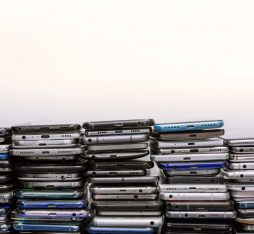Consumers are increasingly mindful of the environmental impact of manufacturing and using smartphones. To cut through the vast amount of information made available by mobile providers, five European telecoms operators launched the Eco Rating scoring system in 2021.
Now, a score accompanied by the Eco Rating logo will be displayed alongside smartphones’ other features at points-of-sale and on the websites of the carriers in the consortium, including Orange.
Eco Rating is the result of a collaboration between Deutsche Telekom, Orange, Telefónica, Telia Company and Vodafone. With input from a number of manufacturers, the initiative has succeeded in defining an environmental impact reference framework based on a common set of indicators. The aim is to make manufacturers’ data on cell phones more transparent and cohesive in order to reveal the environmental impact of phones throughout their lifecycle.
Rating Every Step in a Smartphone’s Life
From the extraction of the raw materials required for manufacturing to their disposal and recyclability, every step is rated according to specific environmental indicators. The greater the environmental impact, the lower the score. The tested devices receive an overall score out of 100, based on 19 criteria. In addition, they will be evaluated against 5 indicators: durability, reparability, recyclability, climate efficiency and resource efficiency. For example, the methodology examines the amount of rare-earth elements used to manufacture parts, the distance traveled to transport the smartphones and the raw materials used in their packaging. The assessment may include the length of time for which manufacturers have committed to continue making the spare parts for repairing their phones. “Premature replacement of smartphones has considerable environmental consequences. So the idea is to make them easy and affordable to repair, because if the repair is as expensive as buying a brand new device, then unfortunately the choice is all too easy,” says Bruno Sciboz, who is in charge of the partnership between Orange and the EcoRating consortium.
Now, a score accompanied by the Eco Rating logo will be displayed alongside smartphones’ other features at points-of-sale and on the websites of the carriers in the consortium. Orange started this practice a year ago in Poland, Spain and Romania, and more recently in France and Belgium. “This label helps consumers to identify and compare eco-friendly cell phones. It’s also a way to reinforce Orange’s commitment to being a trusted carrier,” says Hajar Zenasni, who is in charge of deploying the Eco Rating program at Euro8.
Eco Rating also encourages suppliers to develop more responsible products. More than 240 cell phones have already been assessed using the methodology developed by the consortium, with technical support and supervision from Ihobe (a Basque public body specialized in economic development and environmental protection) and in collaboration with manufacturers. Drawing on scientific knowledge from industry and best practices amassed through previous environmental labeling initiatives, Eco Rating uses the latest standards and guidelines from the European Union, ITU-T (International Telecommunication Union Telecommunication Standardization Sector), ETSI and ISO (International Organization for Standardization).
Supporting Cell Phone Manufacturers
With this label, the consortium is helping cell phone manufacturers to reduce their environmental impact in a very tangible way. For example, these measures can prompt manufacturers to change something simple like a connector, which will extend the life of a phone. When you multiply this by hundreds of millions of smartphones every year, the environmental impact of these changes becomes significant. “It’s also a way to make people realize that manufacturers can take very simple steps to extend the life of a smartphone, make it easier to repair or even encourage recycling,” explains Sciboz.
The consortium is also there to reassure them if they receive a low score for a cell phone. In these cases, they are provided with ways to improve their score based on specific areas where they can reduce their impact. “This data sharing between manufacturers and carriers results in a kind of peer pressure. Suppliers are interested to see how they compare to one another,” says Zenasni. The consortium’s global analysis helps cell phone manufacturers to adhere to this approach, even if it can sometimes lead to additional costs generated by changing certain manufacturing processes. The initiative encourages cell phone manufacturers to make responsible choices in an environment where they face few legal constraints.
Through licensing agreements, other carriers around the world have just joined the consortium. For example, Proximus in Belgium and NOS in Portugal.
The consortium currently has no plans to extend this scoring system to other mobile devices such as tablets, connected objects or laptops.





